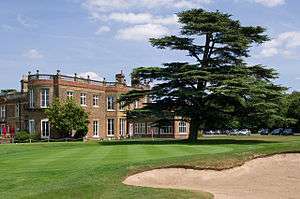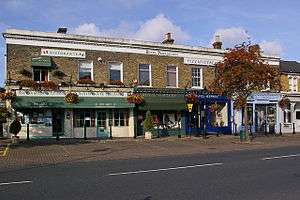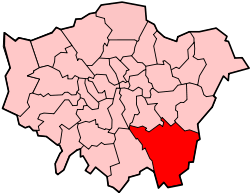Chislehurst
Chislehurst (/ˈtʃɪzəlˌhɜːrst/) is a suburban district in southeast London, England, within the London Borough of Bromley. It borders the London Boroughs of Bexley and Greenwich, and lies east of Bromley and southwest of Sidcup. It is 10.5 miles (16.9 km) southeast of Charing Cross. Chislehurst is in the historic county of Kent.
| Chislehurst | |
|---|---|
 Chislehurst village sign | |
 Chislehurst Location within Greater London | |
| Population | 14,831 (2011. Ward)[1] |
| OS grid reference | TQ445705 |
| London borough | |
| Ceremonial county | Greater London |
| Region | |
| Country | England |
| Sovereign state | United Kingdom |
| Post town | CHISLEHURST |
| Postcode district | BR7 |
| Dialling code | 020 |
| Police | Metropolitan |
| Fire | London |
| Ambulance | London |
| UK Parliament | |
| London Assembly | |
Toponymy
The name "Chislehurst" is derived from the Saxon words cisel, "gravel", and hyrst, "wooded hill".
Present features
Chislehurst is largely a residental area.[2] Chislehurst West, previously known as "Pricking" or "Prickend", includes the biggest of the ponds and the High Street which has many pubs and restaurants.
A local attraction is Chislehurst Caves. They were originally used to mine flint and chalk. During World War II, they were used nightly as an air-raid shelter. There is a chapel inside. A child was born in the caves during World War II and was given a middle name of 'Cavena'.[3] The caves have also been used as a venue for live music; Jimi Hendrix, the Who, the Rolling Stones, David Bowie , Pink Floyd and Led Zeppelin have all played there.
Chislehurst is one of the starting points for the Green Chain Walk, linking to places such as Crystal Palace, Erith, the Thames Barrier and Thamesmead.
Chislehurst Common (and nearby St Paul's Cray Common) were saved from development in 1888 following campaigns by local residents. They were a popular destination for bank holiday trips in the early 20th century, and now provide a valuable green space. Nearby Petts Wood, Hawkwood and Scadbury have also been preserved as open spaces following local campaigns.
Chislehurst Conservation Area
A 2017 list shows there have been 596.4 hectares (1,474 acres) in Chislehurst designated as conservation areas since 1971.[4] The designation of conservation areas is one of the many planning tactics used in the United Kingdom that includes local planning authorities (LPA's), with plans working in conjunction such as the listing of buildings and scheduled monuments, metropolitan Green Belts, National Trusts, and "Tree Preservation Orders". These give stringent policies against development with statues and non-statutory orders. The destruction of many trees and Victorian style buildings caused by bombing during WWII, as well as the ensuing building boom, made protection even more critical. The end result is the protection of areas by preventing arbitrary destruction from large as well as small-scale development that can cause a creeping effect into side spaces and back gardens.[5]
Camden Place




Camden Place (now Chislehurst Golf Club, 51° 24′ 40.05″N 0° 3′ 55.69″E ) takes its name from the antiquary William Camden, who lived in the former house on the site from c. 1609 until his death in 1623. The present house was built shortly before 1717, and it was given a number of additions in the late 18th and very early 19th centuries by the architect George Dance the younger.[6]
In about 1760, the house and estate were bought by Charles Pratt, the Attorney General, and later Lord Chancellor. Pratt was ennobled in 1765, taking the title Baron Camden, of Camden Place; in 1786, he was created Earl Camden. The house is a Grade II* listed building.[7]
A later occupant of the house, from 1871 until his death there in 1873, was the exiled French Emperor, Napoleon III. His body and that of his son, the Prince Imperial, were originally buried in St Mary's Church, before being removed to St Michael's Abbey, Farnborough.[8] The Emperor's widow, the Empress Eugénie, remained at Camden Place until 1885.
There is a memorial to the Prince Imperial on Chislehurst Common, and the area's connections with the imperial family are found in many road names and in the local telephone code, 467, which in its earlier format corresponded to the letters IMP (for imperial).
Past features
The Chislehurst civil parish formed an urban district of Kent from 1894 to 1934.[9] In 1934 it became part of the Chislehurst and Sidcup Urban District,[10] which was split in 1965 between the London boroughs of Bromley and Bexley.
The Walsingham family, including Christopher Marlowe's patron, Sir Thomas Walsingham and Queen Elizabeth I's spymaster, Francis Walsingham, had a home in Scadbury Park, now a nature reserve in which the ruins of the house can still be seen.[11]
A water tower used to straddle the road from Chislehurst to Bromley until it was demolished in 1963 as one of the last acts of the Chislehurst and Sidcup UDC. It marked the entrance to the Wythes Estate in Bickley, but its narrow archway meant that double-decker buses were not able to be used on the route.
Education
- Bullers Wood School
- Chislehurst School for Girls
- Coopers School
- Saint Nicholas Church of England Primary School
- Babington House School
- Farringtons School
- Chislehurst C of E Primary School
- Edgebury Primary School
- Red Hill Primary School
- Mead Road Infant School
- Marjorie McClure Special School
Notable residents
- Louis-Napoleon Bonaparte, President of France and Emperor of the French, lived in exile (1871-1873) in Camden Place.
- William Camden (1551–1623), Clarenceux King of Arms, lived in the house later known as Camden Place from c.1609 until 1623
- Malcolm Campbell, former land and water speed record holder, was born in Chislehurst and is buried in St. Nicholas Parish Church
- George Somers Leigh Clarke (1822–1882), architect who lived at Walpole, Manor Park and is buried in the St Nicholas' churchyard.
- Richmal Crompton, author of the Just William series of books.
- Tilly Keeper, who plays Louise Mitchell in BBC One soap opera EastEnders.
- E. J. May (1853–1941), architect, lived locally and designed a number of local buildings.
- Eugénie de Montijo, Countess of Teba and Empress of France.
- Jozef Michal Poniatowski, Polish nobleman, composer.
- Charles Pratt (1714–1794), Earl Camden, a British politician, who lived at Camden Place
- Peter Redpath, Canadian businessman.
- Siouxsie Sioux, singer, best known for being in the band Siouxsie and the Banshees
- Thomas Townshend; the city of Sydney, Australia is named after him.
- Francis Walsingham, spymaster to Elizabeth I.
- Alan Watts, philosopher, born and raised in Chislehurst, moved to the United States in 1938.
- William Willett, a campaigner for daylight saving time, lived most of his adult life in Chislehurst.
- Ted Willis, creator of Dixon of Dock Green.
- William Hyde Wollaston, chemist and physicist who discovered rhodium and palladium.
Places of worship
- Chislehurst Baptist Church
- St Patrick's Catholic Church
- Christ Church Chislehurst
- Elmstead Baptist Church
- Chislehurst Methodist Church
- The Annuncation
- St. Nicholas
- Darul Uloom Mosque and School
- Ichthus Christian Fellowship
- St Mary's Roman Catholic Church, original burial place of Napoleon III and his son, the Prince Imperial
Transport
Rail
Chislehurst railway station links the area with Southeastern services to London Charing Cross, London Cannon Street via Lewisham and to Sevenoaks via Orpington.
Bus
- 61 to Bromley North via Orpington
- 160 to Catford via Eltham and to Sidcup
- 161 to North Greenwich via Eltham and Woolwich
- 162 to Eltham and to Beckenham Junction via Bromley
- 269 to Bexleyheath via Sidcup and to Bromley North
- 273 to Lewisham via Grove Park and to Petts Wood
- R7 to Chelsfield Village via Orpington
Nearby areas
Chislehurst borders New Eltham to the north, Sidcup to the north east and east, St Paul's Cray to the south east, Petts Wood to the south, Bickley to the south west, Elmstead to the west and Mottingham to the north west.
References
| Wikimedia Commons has media related to Chislehurst. |
- "Bromley Ward population 2011". Neighbourhood Statistics. Office for National Statistics. Retrieved 10 October 2016.
- "Name: History of London Borough of Bromley". Ideal Homes. Retrieved 24 June 2019.
- The baby was christened Rose Cavena Wakeman according to the official guides. Birth records show that a baby called Rose L.C. Wakeman was born in Chislehurst in 1946, which is consistent with the story.
- Hall, Leo. "A New Inventory of English Conservation Areas (2017)" (PDF). Retrieved 27 June 2019.
- Holt, Laurie (February 2008). "Chislehurst Conservation Area" (PDF). Retrieved 28 June 2019.
- Bridget Cherry and Nikolaus Pevsner, London 2: South, Buildings of England (Harmondsworth, 1983), p. 180.
- "Name: CAMDEN PLACE List entry Number: 1064325". English Heritage. Retrieved 25 January 2018.
- Chisholm, Hugh, ed. (1911). . Encyclopædia Britannica. 6 (11th ed.). Cambridge University Press. p. 247.
- Vision of Britain - Chilsehurst UD (historic map)
- Vision of Britain - Chislehurst and Sidcup UD (historic map Archived 30 September 2007 at the Wayback Machine)
- Friends of Scadbury Park
